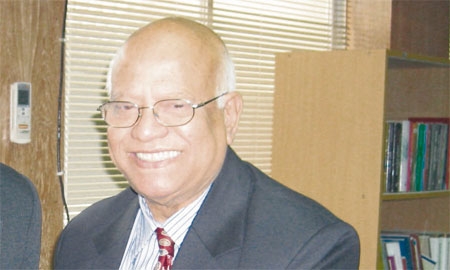Amid the unprecedented global financial crisis Bangladesh has managed to keep its head above water. Bangladesh achieved a GDP growth of 5.74 per cent in the 2008-09 fiscal year and the Medium Term Macroeconomic Framework has envisaged it will only keep growing. An anticipated GDP growth of 6.7 per cent is expected for the 2010-11 fiscal year, with a gradual increase to 7.2 per cent and 7.6 per cent in 2011-12 and 2012-13 respectively. A combination of all of the sectors of Bangladesh are to thank, as reforms and projects are being done in every area to make Bangladesh’s potential more obvious to investors. Abul Maal Abdul Muhith, a renowned economist, diplomat, freedom fighter, language veteran, and now currently the Finance Minister of Bangladesh, feels confident that through the multiple projects in various sectors that he oversees, these investments will be achieved. “I think the potential here is easy to recognise, and investors will continue to come and invest in Bangladesh. Billions of dollars need to be invested in power, roads, highways, and obviously in railways. So, we are appealing for higher foreign investments and high foreign assistance. So far we are receiving strong responses from investors. They have increased their commitment to the country even though there are a number of problems we continue to work to correct,” he says.
One sector getting a lot of attention is power and energy. Due to power outages and an overall lack of power in many parts of the country investors have been discouraged. The government has yet to provide gas connections to more than 250 new industrial units and some 5,000 new apartments, causing serious setbacks for the industries involved. However steps have already been taken to combat the problem with the signing of an agreement with Qatar. “Now we are going to try something different by using coal along with gas, which is our main source of power right now,” Mr Muhith says. “We are going to import LNG (liquefied natural gas). Half a billion tonnes of LNG will be imported from Qatar. So I hope we will be able to correct our electricity crisis very soon.” The government has given highest priority to the power sector development and is committed to ensure availability of electricity to all by 2021 by following the Power System Master Plan 2010. To fulfil the growing demand of electricity, various short, medium and long-term generation, distribution and transmission projects are at different stages of implementation. According to the existing generation expansion programme, a total of 11,456MW of new generation will be added to the national grid by the end of 2015. In addition to power generation, initiatives have also been taken to build new transmission and distribution infrastructure along with renovation and maintenance of the existing ones for reliable and quality power transmission and distribution networks to ensure regular and uninterrupted power supply to the consumers.
“SOUTH-EAST ASIA IS GROWING VERY FAST. SO, IF WE CAN MAKE TRANSIT FACILITIES AVAILABLE WITH THESE COUNTRIES I THINK THE ECONOMY OF BANGLADESH WILL GROW RAPIDLY.”
|
Another sector that is growing rapidly is transportation. Being linked with South-East Asia has forced Bangladesh to keep up with the rapid growth of this particular industry. “We are looking to improve the transit traffic through government policies,” explains Mr Muhith. “Transit to any country will become available in Bangladesh. South-East Asia is growing very fast. So, if we can make transit facilities available with these countries I think the economy of Bangladesh will grow rapidly.”
A total of 119 development (or investment) projects, including six JDCF (Japan Debt Cancellation Fund) projects, were included in the Annual Development Program of Roads and Highways Department for 2009-10. The Ministry of Local Government, Rural Development and Co-operatives (LGRD) has constructed a total of 135,313km (64,691km unpaved roads and 70,622km paved roads). Bangabandhu Bridge is playing a vital role in the road transport system and economy of the country by linking the northwest with the eastern part of Bangladesh. With the assistance of Asian Development Bank, the Bangladesh Railway Sector Improvement Project has been undertaken to modernise Bangladesh’s railways. Projects are also in motion to improve the main ports.
Special emphasis however has been put on the financial management sector, since an efficient financial sector is a prerequisite for economic development. The government has taken a number of initiatives towards reform. The Bangladesh Bank is implementing the Central Bank Strengthening Project with the financial assistance of the International Development Agency. The project started in 2003 and should be completed by the end of this year. The main objective of the project is to transform Bangladesh Bank into a modern and dynamic institution capable of playing appropriate regulatory and supervisory role in the monetary and banking sector.

0 COMMENTS